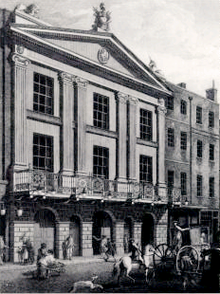
The Actor Rebellion of 1733 was an event that took place at the Theatre Royal, Drury Lane in London, England, when the actors who worked there, disapproving of the changes in the management, attempted to seize control. Before the rebellion, the theatre was controlled by the managers Theophilus Cibber, John Ellys, and John Highmore. When Theophilus lost his share and was denied a bid to run the theatre, he, along with other actors, attempted to take over the theatre by controlling the lease. When the shareholders found out, they refused to admit the actors to the building and the theatre was closed for several months. The fight spilled over to the contemporary newspapers, which generally sided with the managers.
The Theatre Royal reopened on 24 September 1733 with a new company of actors, though they were less experienced and talented than the old crew. The majority of old actors moved to the Little Theatre, Haymarket, though a few remained loyal. Henry Fielding sided with the managers and produced several plays to aid the Theatre Royal, though this caused a backlash when the rebelling actors finally won the dispute. By the end of 1733, the rebellious actors managed to seize legal control of the theatre's property and Highmore, the sole manager of the Theatre Royal at the time, lost all legal abilities to stop them. By February 1734, he sold his shares to Charles Fleetwood who then made an agreement with the actors that secured their return.
